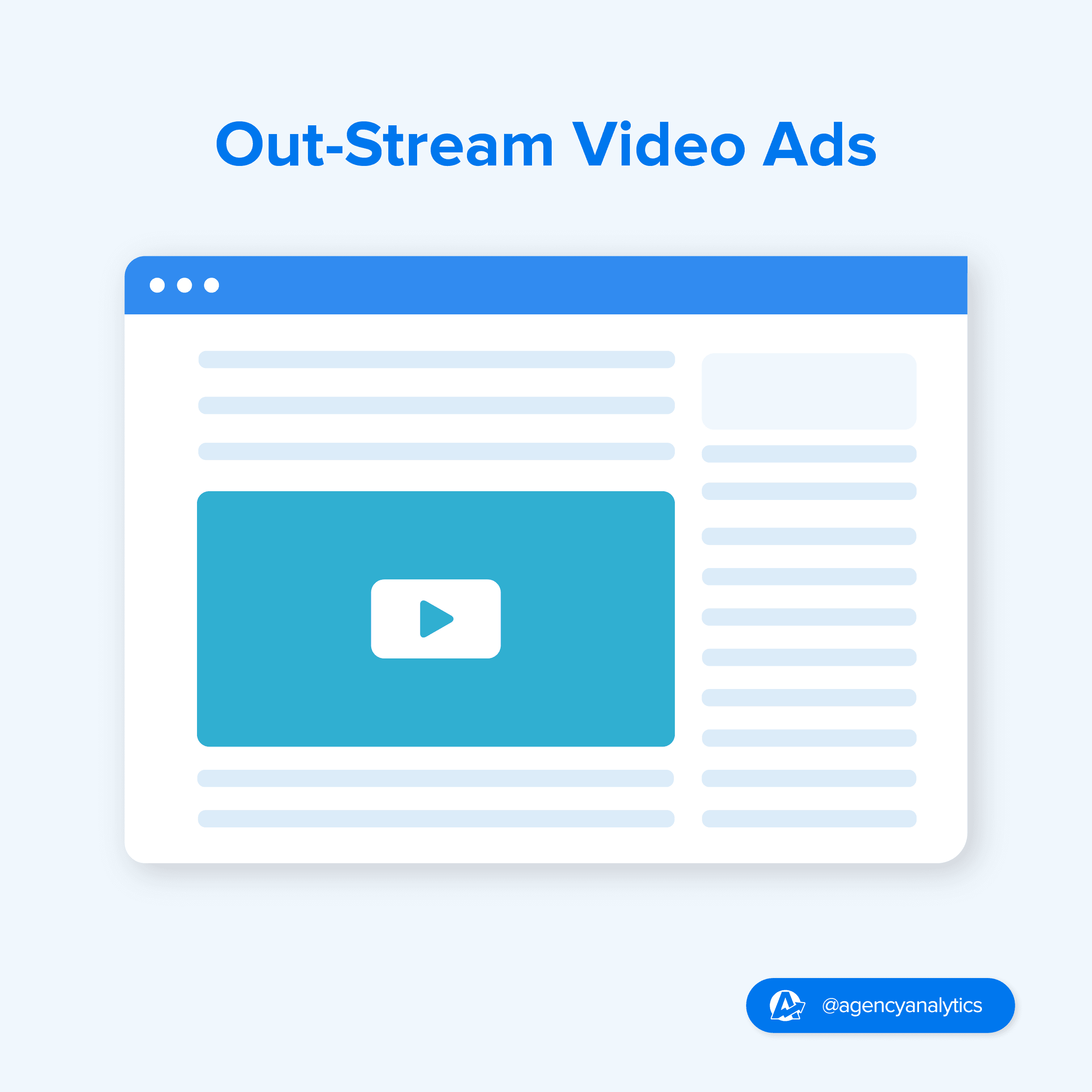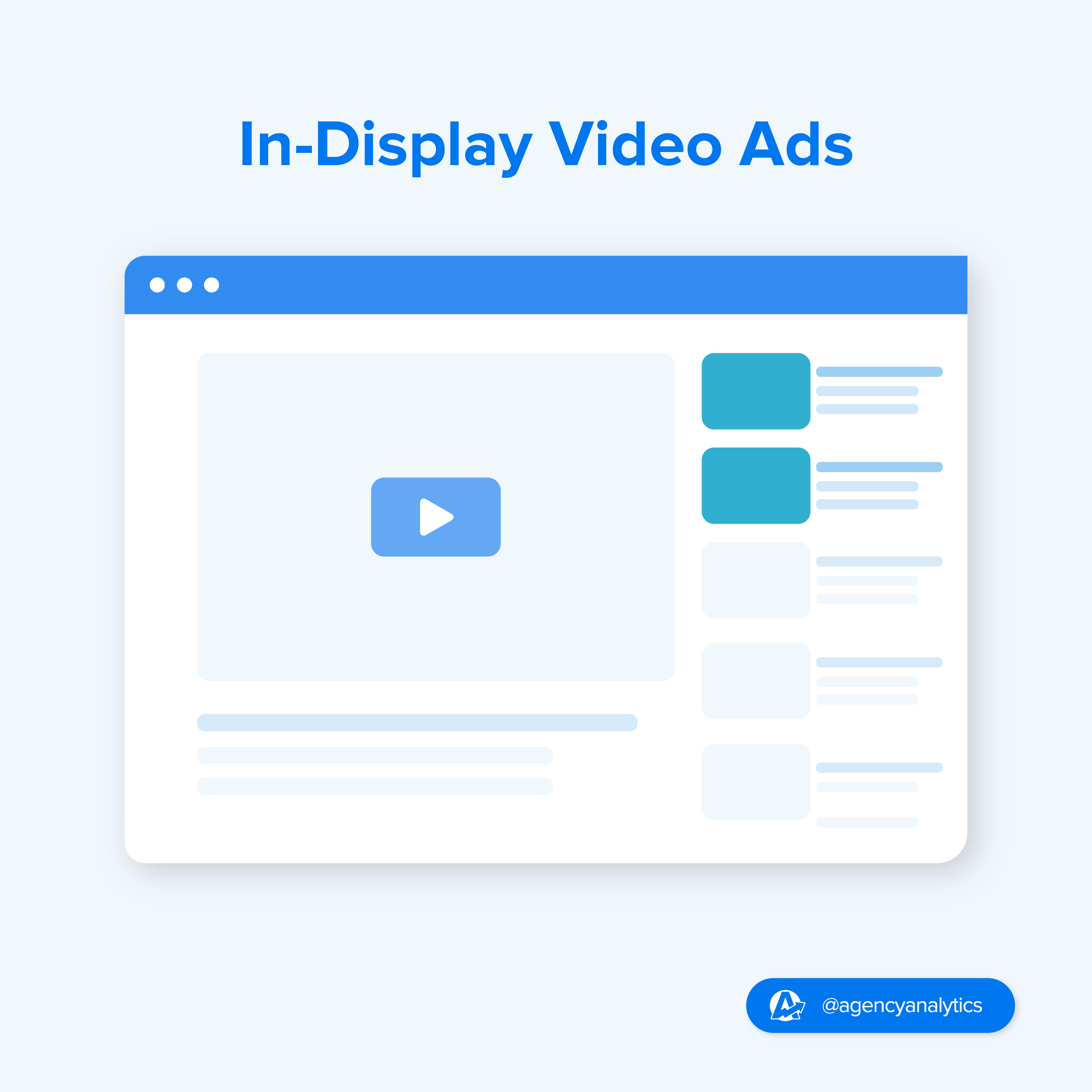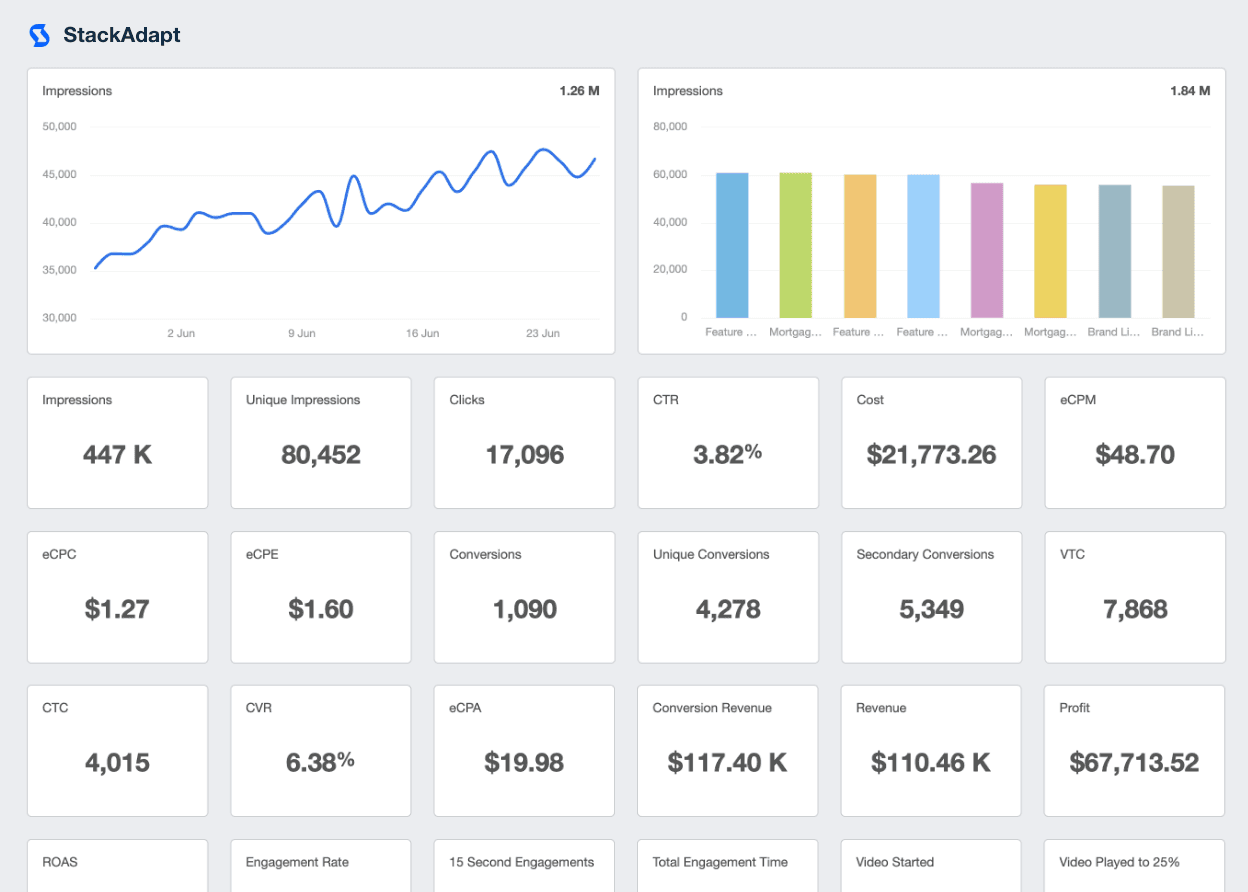Table of Contents
Table of Contents
- What Is Programmatic Video Advertising?
- Most Common Types of Video Ads Used in Programmatic Advertising
- How Does Programmatic Video Advertising Work?
- The Pros of Programmatic Video Advertising for Your Agency Clients
- Challenges of Programmatic Video Advertising
- 4 Steps to Successful Programmatic Video Advertising Campaigns
- Programmatic Video Advertising for Successful Client Campaigns
7,000+ agencies have ditched manual reports. You can too.
Free 14-Day TrialQUICK SUMMARY:
Programmatic video advertising uses automation to buy and manage online video ad spaces. It enhances ad reach, targeting, and scalability, making it an important part of digital marketing campaigns. This approach optimizes ad networks and improves audience engagement across platforms like YouTube, TikTok, and OTT services.
No agency–and no client–is one-size-fits-all, but if there’s only one thing you recommend to your clients right now, investing in more video ads and leveraging the technology to make those ad dollars go further is a solid choice.
Using programmatic video is a trend that isn’t going away any time soon. Consumers have migrated from traditional TV commercials to watching video ads online, requiring agencies to adopt a more sophisticated approach to video marketing.
Programmatic video advertising meets this demand by offering a more efficient way to manage ad networks and optimize video ad inventory, all while ensuring the reach is both targeted and scalable.
Whether it's in-banner video ads or full-length commercials, programmatic video advertising has become a cornerstone of today's digital advertising campaigns. The automation and data-driven nature of this method offer unprecedented efficiency in ad network management and engaging audiences at scale. All of these factors make it an indispensable part of digital campaigns.
What Is Programmatic Video Advertising?
Let’s start with a 101-level intro (or quick refresher) on programmatic video advertising. Basically, programmatic video advertising refers to the use of automation technologies to buy the best possible ad space for your online videos, within your specific budget and parameters.
Though it sounds new, it’s actually existed since the ‘90s, but it’s changed a lot since then. You may also hear it referred to as “programmatic media buying”, “programmatic marketing” or “Real-time bidding” (RTB). Though many use RTB synonymously, it’s actually only a component of programmatic video advertising.
Let’s say you’re producing a video for your client, or coordinating its publication. Just think of how tedious it’ll be for one of your staff to research the target audiences and scour the internet for YouTube channels, blogs, TV shows, and other places where this ad may be seen by relevant audiences.
That’s why programmatic advertising is the way to go. Programmatic video advertising works across a range of platforms, including websites and blogs, TikTok, Facebook, Snapchat, and YouTube, as well as “over-the-top” (OTT) video, which is video delivered to the viewer via the internet (think online subscription streaming services and live streams, such as specialty TV channels that don’t rely on traditional cable).
Video advertising is the best medium to show off a brand's personality and the benefits of a product or service.
Paul Echols, Creative Director and Owner, Square 205
Most Common Types of Video Ads Used in Programmatic Advertising
What does a programmatic video ad look like? Where does it appear? How is it different from creating a regular video that you post to the client’s YouTube channel? Glad you asked.
There are a few kinds of common video ads that are used in a programmatic ad exchange. You’ll want to be familiar with the various types so that you can propose the ones best suited to your client’s brand and goals.
In-Stream Video Ads
Remember back in the day when we had commercials? You know, ads that played in the middle of your show, the perfect time to run and grab a snack or dash to the washroom? In-stream ads are the 2023 equivalent. As part of the linear structure of the video, in-stream ads appear (that is, disrupt) either before, during or after the video content. Sometimes, they’re skippable; other times, they’re not, depending on what the advertiser paid for.
In-stream ads that appear before the video content are known as “pre-roll”
Ads that interrupt during the video are called “mid-roll”
Ads that play after the video content are known as “post-roll”

Out-Stream Video Ads
Also known as native video ads, these video ads take a different approach to their disruptive in-stream counterparts. Outstream ads tend to autoplay as the user scrolls by, appearing mainly in text content on websites and blogs, but also as video ads that autoplay as you scroll through various social media feeds. Sometimes, users mistake them for organic content.
While some people find out-stream videos a nuisance that clutters the content, they provide a lot of flexibility to advertisers.

In-Display Video Ads
This type of video ad placement offers users a sense of choice. They don’t auto-play and need to be clicked on by the user. They appear in premium ad space, for instance, at the top of your YouTube feed or in banners on web pages.

We prefer versatility as it gives the client the most bang for their buck–15 second videos that can also be used in Facebook in-stream placement and Instagram stories, for example. We don't have a preference for pre-roll or mid-roll, but we do find the best ROI comes from in-stream. We utilize non-skippable ads for brand awareness campaigns and prefer skippable ads for boosting conversions.
Michelle van Blerck, Communications Manager at Digital Freak
How Does Programmatic Video Advertising Work?
Programmatic video advertising allows marketing agencies and brands to buy ads through what’s known as an “ad exchange”. Though it’s by no means simple, it is fast and automated. And when we say fast, we mean really fast. Like, it usually takes less than a second.
Here’s the short version of how it works.
A user–such as a member of your target demographic–interacts with the publisher online. For example, let’s say it’s a young woman in New York City who is scrolling on YouTube.
In this example, YouTube is the publisher. The publisher’s programmatic platform (known as the supply-side platform or SSP) places an ad impression up for auction and provides information about the user, such as her device type or browsing habits. That’s right. That woman’s individual impression is up for auction in real-time.
Your programmatic platform (known as the demand-side platform or DSP), that is already set up to know your client’s goals, target audience, and budget, evaluates the potential impression and bids.
If yours is the winning bid, that user will see your video ad.
It’s pretty incredible when you stop and think about it. Even just a few short years ago, many marketing agencies were still dealing with far more tedious and time-consuming processes to achieve far less impactful outcomes.
Video allows for a multi-touch and top-to-bottom client funnel interaction depending on its application and platform distribution method whilst driving more engagement, brand interaction, and shareability.
Narelle Greenland, Head of Product and Partnerships, Thinkify Digital
The Pros of Programmatic Video Advertising for Your Agency Clients
It’s no wonder why well over 80% of all video transacting now happens via programmatic video ads. We’re on track to spend more than 720 billion on programmatic ads by 2026.
Why has programmatic video advertising exploded to such a degree in recent years? Video content now accounts for approximately 82.5% of all web traffic. On Facebook alone, users watch 6 billion minutes of video every single day.
However, it is slow and inefficient for an employee–like a marketing account manager or a media buyer–to buy ad space on a placement-by-placement basis, negotiating with each publisher or platform at a time, one ad at a time. So, if you haven’t tried programmatic yet, it’s time to get with the program. (Sorry. I couldn’t help myself.)
Whether your audience is 22 or 62, and whether your client is a B2C or even B2B company, video marketing–both paid and organic–is the way forward in 2024 and beyond.
Programmatic video advertising has the distinct advantages of being:
Streamlined
Probably the biggest advantage for marketing agencies (and by extension, their clients) is the efficiency of the ad exchange process, which allows for a reach that otherwise isn’t humanly possible. This frees up marketer’s time to devote to the kinds of tasks that can’t be done by a machine.
Relevant
The user data available to target specific demographics mean that the impressions of your video ad are likely to be highly relevant. Think of it as the difference between a canon blast and a sharpshooter.
Scalable
Unlike the old days when the hunt for relevant ad space was done manually, programmatic advertising works machine to machine. This means it is infinitely scalable. No matter the number of publishers (e,g, the potential places for your video ad), it can be evaluated against your criteria and made available to you, without increasing your effort.
Customizable
The key advantage of programmatic video advertising is that it allows for unprecedented customization and targeting, to maximize the ROI for your clients. Ideal for personalization, programmatic video ads can be fine-tuned to maximize conversion of higher quality leads, all the while ensuring you’re in control of the budget to optimize results.
Video is a big part of our strategy–it's the most informative and interesting way to get your message out. From dynamic animated logos to how-to videos and short format social media videos, it hits all the marks for introducing our clients to solutions, putting our brand out there, and catching your eye in a high-value way!
Michelle van Blerck, Communications Manager at Digital Freak
Challenges of Programmatic Video Advertising
That’s not to say that this exciting, fast-paced, and ever-evolving technology is flawless. It has drawbacks that every marketer should understand. Not that these challenges should stop you from using programmatic advertising–just that understanding the cons and preparing your clients will help you mitigate risk and level-set expectations.
Bots, Fraud, and Increased Spend
Every platform is vulnerable to fraud, and programmatic advertising platforms are no exception. The most common form of fraud are bots, which are used to drive up the prices as you bid on impressions. Having your reporting and metrics under control is your best bet to combat this flaw.
If you’re well equipped to track results, you’ll be able to demonstrate to clients that their video advertising dollars are being well spent.
Reporting Variability
Each platform collects and displays their report data differently. This can make it more challenging and time-consuming to get a clear, accurate picture of how your ads are performing. To combat this challenge, either invest in people-power to monitor and analyze this data, or in tools that make the analytics reporting process streamlined and user-friendly.
Lack of Control and Visibility
It’s not always easy to see how your ad is being positioned on the publisher’s platform and who is actually seeing it–particularly if they’re using ad blockers. Programmatic allows–in theory–for a lot of control, but there are still kinks that need to be worked out.
Instead of relying on the reporting of the individual platforms, consolidate your metrics into one beautiful, understandable command center where it is much easier for your team to identify problems.

Use the StackAdapt reporting dashboard to create impressive video reports in minutes. Try AgencyAnalytics free for 14 days.
Decreased User Data in 2024 and Beyond
As Google phases out third-party cookies in 2024, marketers should prepare to see less relevant leads flowing through their campaigns or the need to bid on impressions despite a lack of in-depth information about those users.
Though we don’t know the extent to which this will affect agencies, it’s best to be prepared. Leverage the data you’re collecting now to build strong audience profiles and search for common demographics to help you target your ads later.
4 Steps to Successful Programmatic Video Advertising Campaigns
Now that we’ve covered what programmatic video advertising is and how it works, it’s time to take a look at how to create successful programmatic campaigns for your clients.
Using programmatic marketing methods creates efficiency and scalability for your agency; not to mention, it increases client satisfaction when you deliver optimal results and back them up with trustworthy, transparent reporting.
Step 1 - Understand Your Clients' Video Advertising Objectives
Don’t set yourself up for failure. Any marketing campaign is dead in the water if your objectives aren’t spelled out and if you and your client don’t agree on what “success” looks like. Programmatic video advertising is awesome, but it’s not a silver bullet.
Here’s how to start your client’s programmatic video campaign the right way:
Identify the client’s video advertising budget.
Define the target audience; get as specific as possible using the data points that will be provided by the SSP.
Set ambitious (but realistic) campaign goals and objectives.
Choose the right metrics that you and the client can agree on as a barometer of success–but make sure that you track them!
Step 2 - Choose the Right Programmatic Video Advertising Platforms
There are many different programmatic video advertising platforms available to marketers and they all have different costs, pricing models, limitations, and reporting capabilities. Depending on the size and makeup of your agency, you may need to be familiar with many different platforms to meet the different needs of your clients.
It’s helpful to think first about your target audience demographic. Where do they spend the majority of their time? What about your clients’ competitors? Where are they investing their dollars? Use the answers to questions like these to determine whether YouTube or StackAdapt might be a better match than Facebook, for example.
YouTube is one part of the marketing puzzle that will help your business stand out from your competitors. Most businesses know that running video ads on Google or Facebook is a necessity these days. But a lot of competition can make it hard to stand out with a smaller budget. YouTube is great for getting your brand out in front of your consumers when you have a smaller marketing budget!
Christina Cypher, Director of Marketing at Click Control Marketing
Step 3 - Craft a Winning Programmatic Video Campaign
Once you’ve determined what you want to achieve, who you want to reach, and how you’ll measure success, it’s time to get into the specifics of the content that will make up the campaign and where it should be published to be most effective.
To plan the campaign strategy:
Produce compelling video ads and corresponding creative based on video marketing best practices for agencies.
Select the right ad formats and placements that align with your client’s audience, goals, and most notably, budget.
Optimize video ad inventory for higher ROI.
It takes work to make a solid ad. Even a simple product ad, if it's more than bouncing around masked-out images in a lame animation, needs an engaging concept, a location, decent lighting, good camera work, and editing.
Paul Echols, Creative Director and Owner, Square 205
Step 4 - Measure and Report on Programmatic Video Advertising Performance
You may think that when you’ve brought this campaign to market you can take a breather. And if you have the right tools, you can (at least a small one). For everyone else, diligently tracking the agreed-upon metrics in a transparent and organized manner is a lot of work and requires the knowledge of an analytics expert or data analyst to derive meaningful insights from the jumble of numbers and ratios. You’ll need to:
Track the KPIs and metrics outlined at the start of the campaign.
Measure campaign performance and, if possible, compare it against the client’s previous benchmarks or industry or regional averages.
Analyze and interpret the data and suggest potential improvements or strategic shifts.
Report on the success of your programmatic video advertising campaign, across multiple video platforms.
There are dozens–if not hundreds–of platforms out there, but here are a few where you can easily track your results:
StackAdapt: Go deeper than just regular metrics such as engagement rate and impressions and get into the weeds as to how long users viewed your videos and listened to your audio.
Simpli.fi: Get granular campaign data on dozens of metrics from Geo Fence and Device analytics to view-through signups, sales, and more.
Google Ads: Monitor performance with up-to-date data on views, click-through rates, and conversions to optimize YouTube Ad campaigns effectively.
Google Display and Video 360 (DV 360): Get at-a-glance and in-depth metrics, depending on the needs of each client.
Agency Tip: Toggling between multiple video platforms will destroy your team’s efficiency come reporting time. To maximize scalability, train your staff on one metrics solution that consolidates data from multiple marketing platforms. That way, you ensure your whole team, from the brand-new marketing intern to the seasoned account manager handling your biggest clients, are all able to quickly and easily produce wow-worthy, client-ready reports.
Programmatic Video Advertising for Successful Client Campaigns
There’s no ifs, ands, or buts about it: programmatic video advertising is hot, and it’s only getting hotter. As the technology evolves exponentially, advertisers (particularly digital marketing agencies) find themselves more and more able to optimize their results while refining their processes to reach peak efficiency.
There is one caveat, though. You can make the best recommendations and set up the most optimized programmatic video ad campaign, but it’s all for naught if you can’t track the metrics and prove your results to your client.
Advertisers are investing some serious money in the programmatic video space, and you’ll differentiate yourself as an agency if you can prove to your clients that it was money well spent.
So why wait to start sending out comprehensive, white-labeled video marketing reports to your clients? Sign up for your free 14-day trial with AgencyAnalytics today.

Written by
Elyse Gagné develops branding and content strategies that unite businesses with their customers. A podcast junkie, you'll find her learning about the latest technologies and brand storytelling techniques while she gardens or hikes.
Read more posts by Elyse GagnéSee how 7,100+ marketing agencies help clients win
Free 14-day trial. No credit card required.





